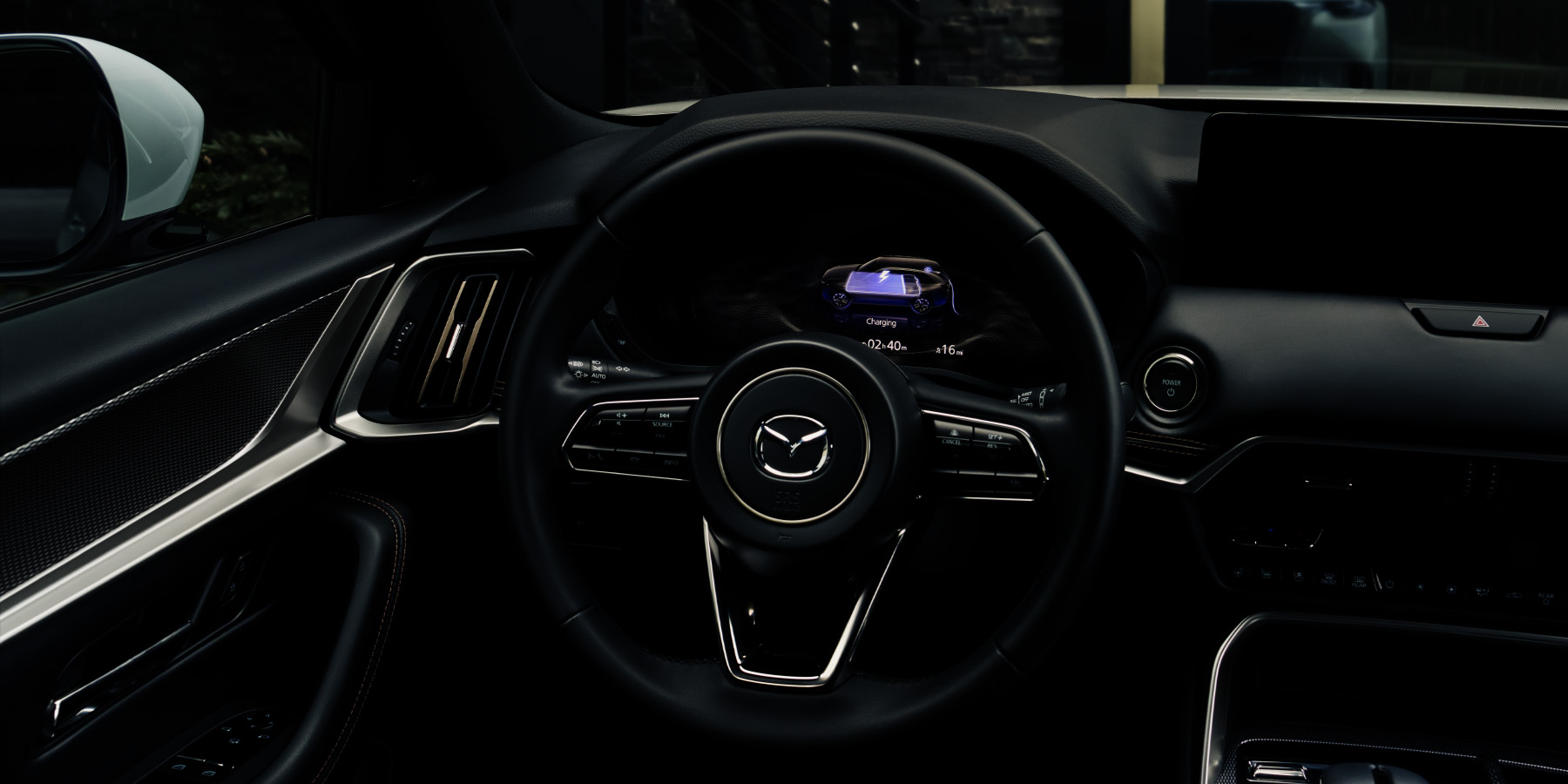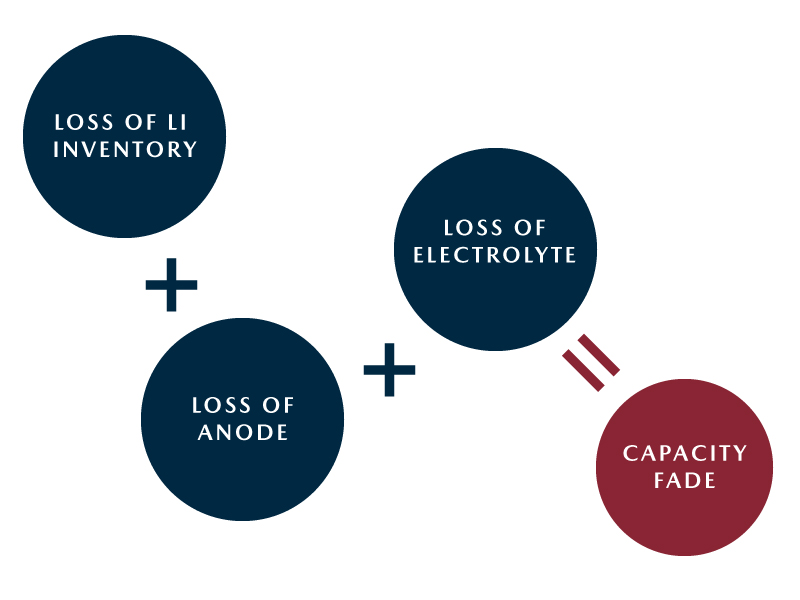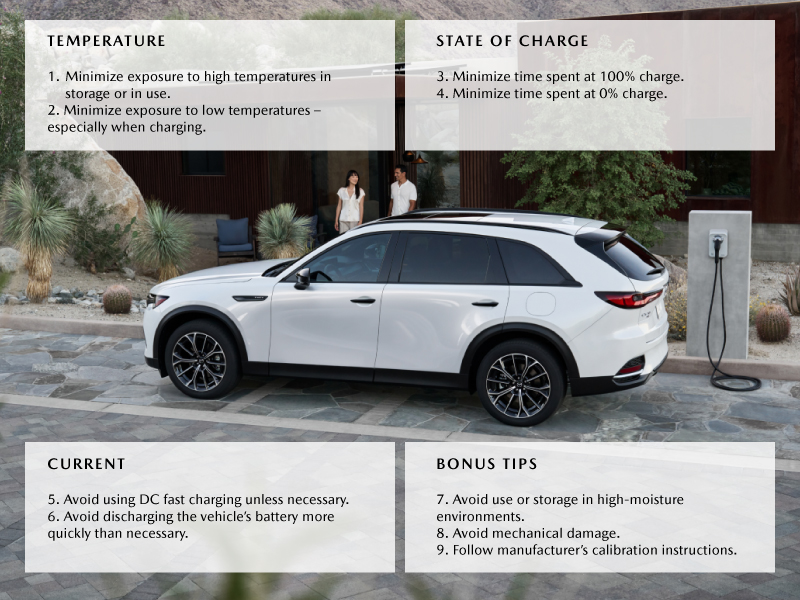EV Battery-Charging Best Practices & Tips

An electric vehicle is like any other vehicle, in that proper use, care, and maintenance of your EV should lead to a better ownership experience and increased residual value. Since an electric vehicle’s battery pack is typically among the most expensive of your EV’s components, it’s worth being informed about how to best maintain its longevity.
The best way to get the most out of your EV battery pack is, as your doctor might say: everything in moderation. Let’s take a closer look at what that means for your everyday driving, charging, and vehicle storage habits.
A note on lithium-ion batteries
The majority of today’s electric vehicles use a lithium-ion battery. So, while there are other battery types, we’re going to focus here on that type of battery.
In simple terms, a battery is a device that stores chemical energy and converts it to electrical energy. This occurs when electrons flow from one material — or electrode — to another, generating an electrical current. In particular, charged ions flow between electrodes through an electrolyte solution, keeping the flow of energy in balance.
As with most chemicals — think of those in your medicine cabinet, for example — degradation will occur within your battery's chemicals over time. In most batteries, including lithium-ion batteries, this may happen in the electrolyte, at the electrodes, or in the solid electrolyte interface (SEI) layers among them.
Degradation of battery performance occurs primarily in two ways: capacity fade and power fade. Capacity fade indicates the amount of energy that can be stored is declining, which affects your EV via decreasing range. Power fade describes the rate at which energy can be pulled from or loaded into the battery — namely, how fast the EV accelerates, manages regenerative braking, and how fast the battery can be recharged.

Generally speaking, the combination of heat and high voltage is more harmful to a lithium-ion battery than frequent discharging and charging. A battery degrades normally from a combination of the loss of lithium ions in electrode active metals, loss of electrolytes, and fewer available electrode active materials.
For more information, please see our article on how high and low temperatures can affect your EV battery’s longevity and ability to hold charge.
Top 5 EV charging best practices
While you can’t control everything your battery does, you can increase your awareness of factors that can encourage battery degradation. These include temperature, state of charge (often abbreviated SOC), load, and charging rate. Here, we’ve outlined some general guidelines for lithium-ion batteries, but your first reference point for your EV or plug-in hybrid electric vehicle (PHEV) should always be the vehicle’s Owner’s Manual — it’s sourced from the same people who designed, engineered, and built your vehicle.

1. Aim for a state of charge between 20% and 80%
Have you ever plugged in your laptop and received a prompt asking if you want the battery charged and held at 80% vs. fully charged? Your laptop (probably) has a lithium-ion battery and laptop manufacturers know that your laptop’s state of charge is more efficient and longer-lasting in that window.
The lithium-ion battery pack in your EV or PHEV is similar, more “stressed” at charge extremes, much like a rubber band stretched to its maximum is more apt to break than when stretched to a moderate percentage of its elasticity. At high or low states of charge, a battery has more internal resistance. As such, it’s best to minimize fast charging within those areas of internal resistance.
Fortunately, most electric vehicles have an app, onboard interface, or both, that allow you to control many aspects of the charging process. You can set them to charge your vehicle both within an ideal state of charge and at a time of day when the ambient temperature is less extreme (and/or when electric rates are lower).
Beyond the chemistry and materials within the battery, charging it, especially with a DC fast charger, from 10/20% to 80% will take approximately the same amount of time as charging from 80% to 100%. To put it another way, it can take as long for your car to finish charging that last 10-20% as it did to charge your nearly depleted battery up to 80%.
This is why many manufacturers, including Mazda, often quote a 20-80% recharge time instead of a full recharge time.
An occasional charge to 100% won’t significantly hurt battery longevity but, on a long trip using DC fast chargers, you’ll often use the same time overall making an extra stop and recharging to 80% rather than waiting out that last 20%.
At the other extreme, a 20% SOC leaves little in the way of reserve for a road detour or a busy charging station. It also means if the vehicle is parked overnight in less-than-ideal conditions, it may drop to minimum voltage, from which charging would have to begin at a reduced rate.
2. Leave your vehicle parked in an area that doesn’t experience extreme temperatures
Similar to Goldilocks’ porridge, it’s best practice to charge lithium-ion batteries when it’s not too hot and not too cold, roughly the same 68°F to 77°F range most humans find comfortable. While the sun won’t shine directly on a battery pack, it does warm the car as a whole, including the battery. Your battery will have to expend energy maintaining its own temperature, but also cooling the cabin of your vehicle. The same phenomenon occurs at lower temperatures; the battery pack supplies energy to heat the cabin and get the battery pack closer to ideal operating temperature.
Anything you can do to limit long-term exposure to extreme temperatures, including parking your vehicle in a garage, under a carport or foliage, or even using a car cover, can help reduce these effects.
3. Avoid charging your vehicle in extreme temperatures
At very cold or very warm temperatures, the battery is already working harder than it does in its “comfort” temperature range.
As temperatures warm, the ion movements within the battery speed up, which makes it more likely they’ll fail to attach to the anode or cathode. The speed and pressure of these ions zipping about may also create small cracks and slow chemical reactions.
In cold weather, the electricity-producing chemical reactions are slower, reducing capacity and output.
Since the battery pack is already under more stress at extreme temperatures, calling on it to do more by using DC fast charging merely adds to this “stress.” Battery and temperature management systems (which also get their power from the battery) may automatically slow the charging rate down for self-preservation.
4. If available, use preconditioning features before charging your EV.
Preconditioning does just what it sounds like — prepare the battery to best accept charging and, in some performance models, prepare it for a quick burst of discharging if the driver plans to accelerate quickly.
If ambient temperatures are hot, such as a summer day in the Southwest desert, the battery pack will likely near or be at its peak operating temperature. In these cases, the onboard systems can use energy from the battery to run a cooling system that keeps the battery from overheating. But if you precondition the car while it’s plugged in, it can instead use that power for thermal management, putting less stress on the battery by keeping it cool. Doing this and running the car’s air conditioner with sufficient power available to precool the cabin also makes climate “control” easier on the battery because it’s using an off-vehicle energy source.
Again, the same can be said for preconditioning in cold temperatures; the off-vehicle energy supply can warm the battery pack to optimal operating temperature without using any of the battery to charge and heat the cabin.
Note: If you are on a long-distance trip, using the car’s native navigation system or accompanying app to set a DC fast charger as a destination or waypoint will usually cause the car to precondition the battery for charging as you near the charging station.
5. When possible, avoid fast charging.
If you have a garage with a Level 2 charger, or a PHEV that will charge overnight on a standard 120-volt wall outlet, you may never need a DC fast charger. However, if you’re going on a road trip during which you will exceed the car’s range in one day — or you don’t otherwise have easy access to a charger — you may need to use a DC fast charger.
While there’s no immediate problem with using a fast charger — especially at moderate temperatures — you may want to avoid using them all the time, as studies have shown that exclusive use of DC fast charges does lead to increased battery degradation, albeit by only a small amount. Research data is still nascent, but it appears DC charging increases battery degradation by 0.1%. If you know you’ll be using a DC charger, always precondition the battery if you can.
Perhaps the biggest reason to avoid DC charging is irrelevant to the battery pack: It costs more, often twice as much as what a Level 1 or Level 2 charger will.
More EV charging tips
● Reduce the need for charging with driving best practice and regenerative braking: As with any energy source, the more efficiently you drive, the less often you’ll need to “refuel.” By maximizing regenerative braking and minimizing quick acceleration and use of climate accessories (AC, heated seats, etc.), you’ll get the most miles from your EV regardless of its battery capacity.
● Practice plug and cable maintenance: Keep an eye on your EV cables, and always check those at public chargers, for the safest charging experience.
● Follow the guidance of your vehicle’s battery management systems (BMS): Every EV has a BMS, and a review of your Owner’s Manual and the various displays available will, if you follow their directions, prolong the life of the battery.
● Keep your vehicle’s firmware and software up to date: Whether or not you’re hesitant to be the first to try it, keeping your vehicle up to date will generally make the ownership and driving experience better, especially as electric vehicles become more common and public EV chargers aren’t as consistently available as gasoline or diesel pumps.
● Fully charge your vehicle on occasion: Your car’s documentation may suggest an occasional session in which you fully charge your EV or PHEV. In most cases, this is so the BMS has an accurate picture of the battery's condition and can better estimate parameters like remaining range.
● Time charging properly: If you don’t need to recharge immediately after or during a long drive, let the battery pack cool a bit before charging commences. Just as your electricity rate at home may vary by time of day, so too it might vary at a public charging station. Be aware of when your EV is charging for the most economical energy consumption.
Charging your Mazda CX-70 PHEV or CX-90 PHEV
In its default Normal drive mode, your Mazda CX-70 PHEV or CX-90 PHEV will choose the best combination of gas engine and electric propulsion, to optimize fuel efficiency. This mode requires no action by the driver. However, the driver can manually choose three other modes or settings to optimize EV driving:
● EV mode, part of Mazda Intelligent Drive Select (Mi-Drive) functionality, will utilize the electrical power stored in the high voltage battery. It will, however, draw down the battery quicker.
● EV Priority mode is a vehicle setting that, when enabled, will automatically begin every drive in EV mode.
● Charge mode is used when the EV battery charge falls below a preset SOC. When engaged, Charge Mode will prioritize battery charging by the gas engine until the battery’s SOC is returned to the driver’s predetermined level. Typically, you’d use Charge Mode on a highway headed to a city where you expect to be driving in EV mode or if you are travelling to a remote location where you may be using the EV battery to power personal appliances you’ve brought like a TV.
Test-drive a Mazda Plug-in Hybrid Electric Vehicle
With a PHEV like the Mazda CX-70 PHEV or CX-90 PHEV, you can use electricity for local trips while never being concerned with charging stations, procedures, or wait times on a road trip or other longer journeys. To put it another way, PHEVs allow you to drive using electric-only propulsion in your day-to-day life without giving up the convenience of five-minute refueling almost anywhere, anytime, when you need it.
Wherever the road takes you, there’s a Mazda vehicle that suits your budget and lifestyle. Shop the Mazda crossover SUVs online, schedule a test drive, or simply visit a Mazda Dealer near you today.
This article is intended for general informational purposes only and is based on the latest competitive information available at the time of posting. Information herein is subject to change without notice and without Mazda incurring any obligations. Please review a variety of resources prior to making a purchasing decision. Visit Resource Center for more articles.




















